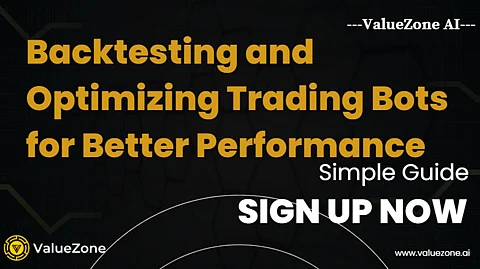

Imagine you're trying out a new recipe for the first time. You wouldn't just throw everything into the pot without thinking, right? You'd probably follow the recipe, make adjustments based on taste, and maybe even cook a small portion first to see how it turns out. That's what backtesting is for trading bots. It's like a trial run where you test your bot’s strategy on past data to see how it would have performed. This way, you can make tweaks and optimize it before letting it trade with your real money.
Backtesting is essential because it helps you understand if your trading bot's strategy is likely to succeed or fail. By testing on historical data, you can see how it would have handled different market conditions, like sudden price drops or big rallies. This process gives you the confidence to use your bot in the live market.
The best performance among trading bots can vary depending on several factors, such as market conditions, the specific strategy employed, and the user's goals. Hence, don’t miss the performance of the trading bot, including ValueZone AI
There are a few key metrics to consider when evaluating the performance of a trading bot:
Net Profit: The total profit made by the bot after accounting for all trading fees and other expenses.
Return on Investment (ROI): The percentage of profit relative to the initial investment. A higher ROI indicates better performance.
Drawdown: The maximum loss from a peak to a trough in the bot's equity curve. A bot with a lower drawdown is generally considered less risky.
Risk-Adjusted Return: Measures how much return the bot generates for each unit of risk taken. Common metrics include the Sharpe Ratio and Sortino Ratio.
Win Rate: The percentage of trades that result in a profit. A higher win rate can indicate more consistent performance.
Monthly/Quarterly Performance: Regular, stable returns over months or quarters are a sign of a well-performing bot.
Performance in Different Market Conditions: A bot that performs well in both bull and bear markets is highly valuable.
Ability to Handle Volatility: Some bots are designed to capitalize on market volatility, which can lead to higher profits in turbulent times.
Community and Expert Reviews: Sometimes, the best-performing bots are those with positive reviews and endorsements from other traders.
Updates and Support: Bots that receive regular updates and have strong customer support tend to perform better over time.
Before anything else, decide on a trading strategy. This could be based on trends, moving averages, or any other method that fits your trading style.
Collect Historical Data: You’ll need past price data to test your strategy. Most trading platforms offer this data, or you can find it online.
Use a trading platform or software that allows backtesting. Input your strategy and let the bot run through the historical data.
Look at the bot's performance. Did it make a profit? How did it handle market volatility? This analysis will help you see where improvements can be made.
After reviewing the results, make adjustments. Maybe your bot needs to buy earlier or sell later. Keep tweaking until you’re satisfied with the performance.
Begin by making minor adjustments to your bot’s settings. This could be changing the time frame it operates on or tweaking its risk management rules.
Optimize for different market conditions. For example, see how your bot performs during a bull market versus a bear market.
Keep Records: Document every change you make and the results it produces. This helps you understand what works and what doesn’t.
Before committing to a paid plan, many platforms offer free trial plans where you can test and optimize your bot in a simulated environment. This is a risk-free way to see how your bot performs without risking real money.
When you sign up with ValueZone AI, you can get a $50 welcome bonus. This bonus can be used to start your trading journey without using your own money.
Take advantage of the free trial plan to test and optimize your bot. This is a great way to get comfortable with the platform before upgrading to a paid plan.
AI High-Frequency Trading Strategies: Invest $100 for 2 days and earn $4 daily.
AI Statistical Arbitrage Strategies: Invest $500 for 3 days and earn $5.50 daily.
AI Cross Market Arbitrage Strategy: Invest $1500 for 7 days and earn $18 daily.
AI Short-Term CTA Strategy: Invest $3000 for 10 days and earn $39 daily.
AI Short-Term Alpha Strategy: Invest $5000 for 15 days and earn $70 daily.
AI Trend Following Strategy: Invest $8000 for 15 days and earn $120 daily.
AI Quantitative Hedging Strategy: Invest $15,000 for 25 days and earn $240 daily.
AI Dynamic Portfolio Strategy: Invest $23,000 for 25 days and earn $391 daily.
AI Capital Weighted Portfolio Strategy: Invest $35,000 for 30 days and earn $630 daily.
AI Momentum Investment Strategy: Invest $50,000 for 30 days and earn $950 daily.
AI Growth Investment Strategy: Invest $100,000 for 45 days and earn $2000 daily.
If you refer friends to ValueZone AI, you’ll earn 3.5% of their deposits. It’s a win-win—you help your friends, and you get rewarded too!
Once your bot is live, keep an eye on its performance. Regular monitoring ensures that your bot works as expected and helps you make any necessary adjustments.
Backtesting and optimizing your trading bot is like preparing for a big game. The more you practice and fine-tune your strategy, the better your chances of success. With ValueZone AI, you can start with a $50 welcome bonus, test with a free trial plan, and even earn referral rewards. So, why not try to see how your bot performs?
The "best" trading bot depends on your specific needs, risk tolerance, and market conditions. It's crucial to backtest and optimize any bot before using it with real money to ensure it aligns with your trading goals. Regularly monitor its performance and adjust the strategy as needed to maintain optimal results.
